Intel’s Tiger Lake 11th Gen Core i7-1185G7 Review and Deep Dive: Baskin’ for the Exotic
by Dr. Ian Cutress & Andrei Frumusanu on September 17, 2020 9:35 AM EST- Posted in
- CPUs
- Intel
- 10nm
- Tiger Lake
- Xe-LP
- Willow Cove
- SuperFin
- 11th Gen
- i7-1185G7
- Tiger King
CPU Performance: Office and Web
Our previous set of ‘office’ benchmarks have often been a mix of science and synthetics, so this time we wanted to keep our office section purely on real world performance.
Agisoft Photoscan 1.3.3: link
Photoscan stays in our benchmark suite from the previous benchmark scripts, but is updated to the 1.3.3 Pro version. As this benchmark has evolved, features such as Speed Shift or XFR on the latest processors come into play as it has many segments in a variable threaded workload.
The concept of Photoscan is about translating many 2D images into a 3D model - so the more detailed the images, and the more you have, the better the final 3D model in both spatial accuracy and texturing accuracy. The algorithm has four stages, with some parts of the stages being single-threaded and others multi-threaded, along with some cache/memory dependency in there as well. For some of the more variable threaded workload, features such as Speed Shift and XFR will be able to take advantage of CPU stalls or downtime, giving sizeable speedups on newer microarchitectures.
For the update to version 1.3.3, the Agisoft software now supports command line operation. Agisoft provided us with a set of new images for this version of the test, and a python script to run it. We’ve modified the script slightly by changing some quality settings for the sake of the benchmark suite length, as well as adjusting how the final timing data is recorded. The python script dumps the results file in the format of our choosing. For our test we obtain the time for each stage of the benchmark, as well as the overall time.
The final result is a table that looks like this:
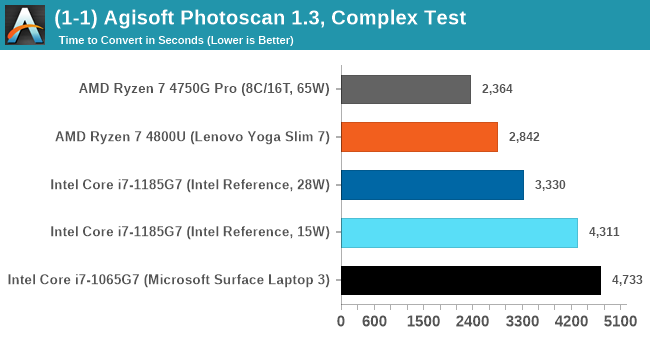
As explained in the power tests, the 4800U with double the cores wins out here, and due to the vector pressure also wins on power efficiency. There’s still a sizeable uplift from Ice Lake to Tiger Lake at 15 W, although 28 W is needed to get something sizeable.
Mozilla Kraken 1.1
Kraken is a 2010 benchmark from Mozilla and does a series of JavaScript tests. These tests are a little more involved than previous tests, looking at artificial intelligence, audio manipulation, image manipulation, json parsing, and cryptographic functions. The benchmark starts with an initial download of data for the audio and imaging, and then runs through 10 times giving a timed result.
Automation involves loading the direct webpage where the test is run and putting it through. All CPUs finish the test in under a couple of minutes, so we put that as the end point and copy the page contents into the clipboard before parsing the result. Each run of the test on most CPUs takes from half-a-second to a few seconds.
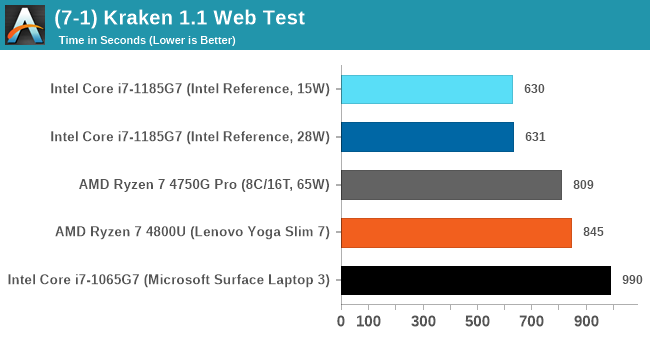
Both the Tiger Lake results are very fast, not showing much difference between the power modes. Intel pushes ahead of AMD here, and ultimately a sizable jump over Ice Lake.
Google Octane 2.0
Our second test is also JavaScript based, but uses a lot more variation of newer JS techniques, such as object-oriented programming, kernel simulation, object creation/destruction, garbage collection, array manipulations, compiler latency and code execution.
Octane was developed after the discontinuation of other tests, with the goal of being more web-like than previous tests. It has been a popular benchmark, making it an obvious target for optimizations in the JavaScript engines. Ultimately it was retired in early 2017 due to this, although it is still widely used as a tool to determine general CPU performance in a number of web tasks.
Octane’s automation is a little different than the others: there is no direct website to go to in order to run the benchmark. The benchmark page is opened, but the user has to navigate to the ‘start’ button or open the console and initiate the JavaScript required to run the test. The test also does not show an obvious end-point, but luckily does try and aim for a fixed time for each processor. This is similar to some of our other tests, that loop around a fixed time before ending. Unfortunately this doesn’t work if the first loop goes beyond that fixed time, as the loop still has to finish. For Octane, we have set it to 75 seconds per run, and we loop the whole test four times.
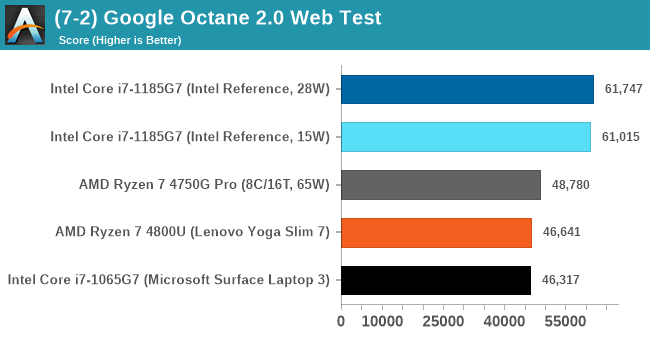
The Tiger Lake system reaches new records in Optane. If there’s anything this system is fast at, it is web workloads.
Speedometer 2: JavaScript Frameworks
Our newest web test is Speedometer 2, which is a test over a series of JavaScript frameworks to do three simple things: built a list, enable each item in the list, and remove the list. All the frameworks implement the same visual cues, but obviously apply them from different coding angles.
Our test goes through the list of frameworks, and produces a final score indicative of ‘rpm’, one of the benchmarks internal metrics. Rather than use the main interface, we go to the admin interface through the about page and manage the results there. It involves saving the webpage when the test is complete and parsing the final result.
We repeat over the benchmark for a dozen loops, taking the average of the last five.
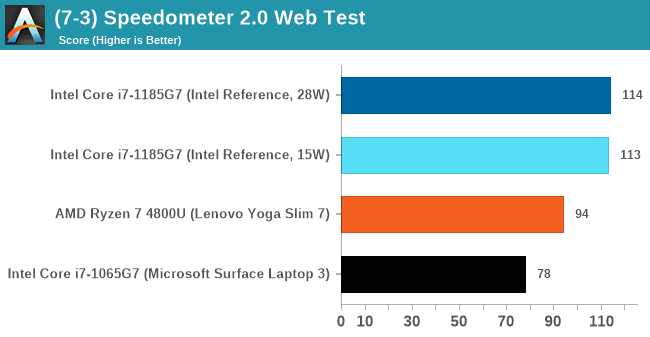
Again, another good win for Tiger Lake.


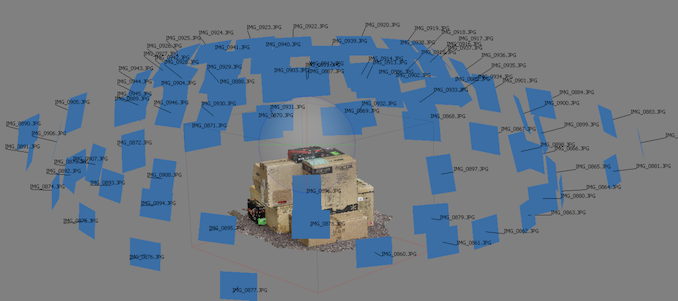
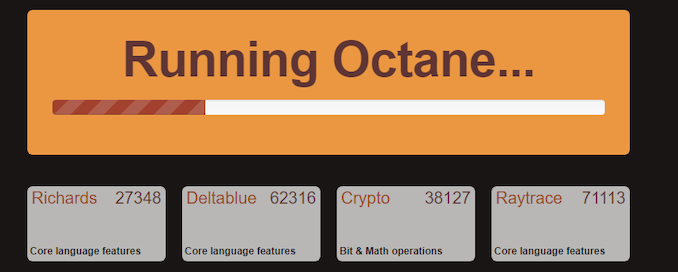
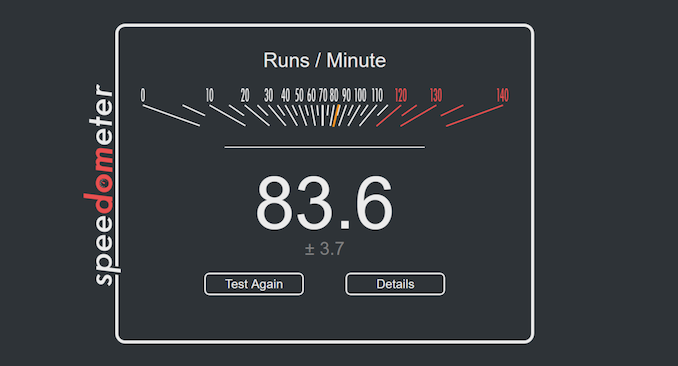








253 Comments
View All Comments
ikjadoon - Thursday, September 17, 2020 - link
You wrote this twice without any references, but I'll just write this once:AMD is literally moving to custom Wi-Fi 6 modems w/ Mediatek (e.g., like ASMedia and AMD chipsets): https://www.tomshardware.com/news/report-amd-taps-...
PCIe4: it doesn't need to 'max out' a protocol to be beneficial and likewise allows fewer lanes for the same bandwidth (i.e., PCIe Gen4 also powers the DMI interface now, no?).
Thunderbolt 4 is genuinely an improvement over USB4. Anandtech wrote an entire article about TB4: https://www.anandtech.com/show/15902/intel-thunder... (mandates unlike USB4, 40 Gbps, DMA protection, wake-up by dock, charging, daisychaining, etc). Anybody who's bought a laptop in the past two years know that "USB type-C" is about as informative as "My computer runs an operating system."
AVX512 / DLboost: fair, nobody cares on a thin-and-light laptop.
LPDDR5 is likely coming in 2021 to a Tiger Lake refresh around CES. Open game how many OEMs will wait; noting very few of the 100s of laptop design wins have been released, I suspect many top-tier notebooks will wait.
Billy Tallis - Thursday, September 17, 2020 - link
I'd be surprised if the chipset is using gen4 speeds for the DMI or whatever they call it in mobile configurations. The PCIe lanes downstream of the chipset are all still gen3 speed, so there's not much demand for increased IO bandwidth. And last time, Intel took a very long time to upgrade their chipsets and DMI after their CPUs started offering faster PCIe on the direct attached lanes.JayNor - Saturday, September 19, 2020 - link
4 lanes of pcie4 are on the cpu chiplet, as are the thunderbolt io. They can be used for GPU or SSD.Billy Tallis - Saturday, September 19, 2020 - link
Did you mean to reply to a different comment?RedOnlyFan - Friday, September 18, 2020 - link
Lol this is so uneducated comment. Telling wrong stuff twice doesn't make it correct.Pcie4 implemented properly should consume less power than pcie3.
Thunderbolt 4 is not USB 4. Only tb3 was open sourced to USB 4 so USB 4 will be a subset for tb3 thank Intel for that.
There are more AI/ML used in the background than you realize. If you expect people to do highly multi threaded rendering stuff.. Why not expect AI/ML stuff?
And 2022 is still 1.5 year away. So amd is entering the party after its over.
JayNor - Saturday, September 19, 2020 - link
Thunderbolt 4 doubles the pcie speed vs Thunderbolt 3 that was donated for USB. Intel has also now donated the Thunderbolt 4 spec.Spunjji - Friday, September 18, 2020 - link
They have 4 (four) lanes of PCIe 4.0 - that provides the same bandwidth as Renoir's 8 lanes of 3.0I get that you're one of those posters who just repeats a list of features that Intel has and AMD doesn't in order to declare a "win", but seriously, at least pick one that provides a benefit.
JayNor - Saturday, September 19, 2020 - link
The m.2 pcie4 chips use 4 lanes. Seems like a good combo with Tiger Lake. AMD would need to use up 8 lanes to match it with their current laptop chips.Rudde - Saturday, September 19, 2020 - link
Problem is that there isn't any reasonable mobile pcie4 SSDs yet. Same problem with lpddr5. Tiger Lake will get them when they become available. Renoir was released half a year ago; all AMD based laptops will wait for next gen before adopting these technologies anyway.If you want to argue that AMD is behind, highlight what Ice Lake has, but Renoir doesn't have.
Spunjji - Saturday, September 19, 2020 - link
Why would they bother? There are no performance benefits to using a PCIe 4 SSD in the kinds of systems TGL will go into. You can't get data off it fast enough for the read speed to matter, and it has no effect on any of the applications anyone is likely to use on a laptop that has no GPU. This is aside from Rudde's point about there currently being no products that suit this use case.